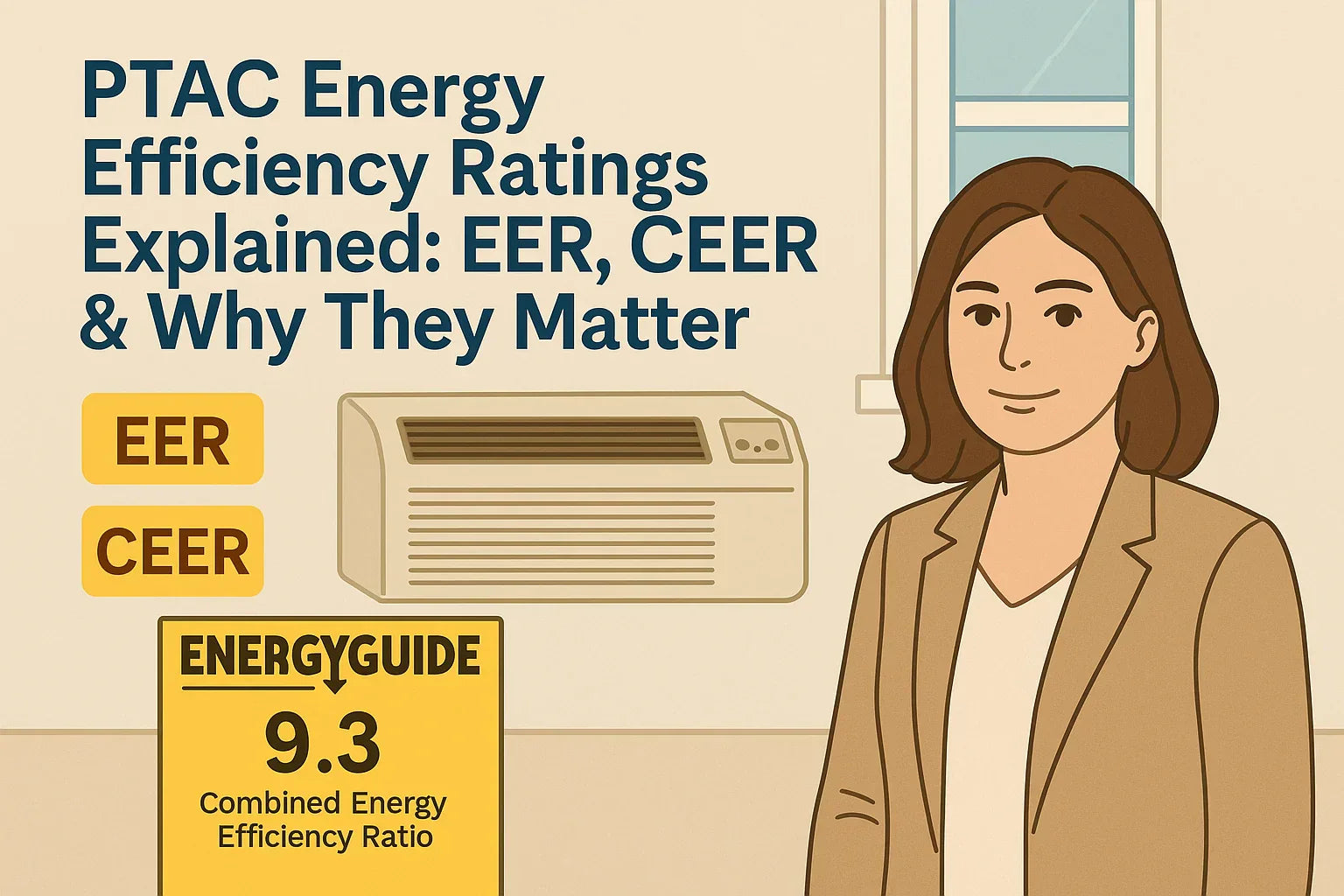When you're shopping for a PTAC (Packaged Terminal Air Conditioner) unit, one of the most important specs to look at is its energy efficiency rating. But what do acronyms like EER and CEER actually mean? And which one should you trust when deciding what’s best for your home, rental, or compact living space?
In this guide, we’ll explain everything you need to know about PTAC energy efficiency ratings, how they affect your electric bill, and why the Hotpoint 7,000 BTU PTAC with Heat Pump and 3.5 kW Heat Kit is a solid performer when it comes to balancing power and savings.
🔢 What Is EER?
EER (Energy Efficiency Ratio) is the ratio of a PTAC’s cooling capacity (in BTUs) to its power consumption (in watts) under specific, controlled test conditions.
Formula:
EER = BTU output / Power input (watts)Key Facts:
-
Tested at a fixed outdoor temperature (usually 95°F)
-
Represents a snapshot of performance
-
Does not include standby or off-mode energy consumption
An EER of 10 means the unit delivers 10 BTUs of cooling for every watt of electricity it uses.
📊 What Is CEER?
CEER (Combined Energy Efficiency Ratio) is a newer, more comprehensive metric introduced by the U.S. Department of Energy.
What It Measures:
-
Cooling performance plus standby/off-mode energy consumption
-
Reflects real-world usage conditions
Why It Matters:
-
Includes energy used when the unit is not actively cooling (but still plugged in)
-
Helps consumers better understand actual energy costs over time
According to Energy Star, CEER is now the preferred and required metric for rating new PTAC units.
🔄 EER vs. CEER: What’s the Difference?
| Metric | EER | CEER |
|---|---|---|
| Measures | Active cooling only | Cooling + standby/off-mode |
| Testing Temp | 95°F fixed | 95°F fixed + standby analysis |
| Real-World Accuracy | Moderate | High |
| Regulation Standard | Old DOE standards | New DOE & Energy Star standards |
| Found On | Spec sheets | EnergyGuide labels, spec sheets |
CEER gives you a clearer picture of how efficient your PTAC will be throughout the year, not just on hot days.
🚗 Why Efficiency Ratings Matter
Energy-efficient PTACs aren’t just better for the planet—they’re better for your wallet, too.
Benefits of Higher EER/CEER:
-
Lower monthly utility bills
-
Better cooling performance per watt
-
Smaller carbon footprint
-
May qualify for rebates or tax incentives
For landlords, property managers, and savvy homeowners like Savvy, choosing an energy-efficient PTAC can result in significant long-term savings.
💲 How Efficiency Affects Your Bills
Let’s compare two similar PTAC units for a 300 sq ft studio apartment:
| Model | CEER Rating | Annual Cooling Cost (Est.) |
| Hotpoint 7,000 BTU PTAC | 9.3 | $185 |
| Standard Budget PTAC | 8.0 | $230 |
Yearly Savings:
$45 per unit, per year. Over 10 years? That’s $450 in savings from just one unit.
Multiply that by several rooms, and it’s easy to see why hotel chains and apartment owners prioritize CEER.
🌬️ Where to Find CEER and EER Ratings
Look for:
-
Yellow EnergyGuide labels on product pages or units
-
Manufacturer specification sheets
-
Energy Star certification badges
CEER ratings for PTACs generally range from 8.5 to 11.0.
🔧 Example: Hotpoint AHHS07D3XXA Efficiency
Efficiency Specs:
-
EER: ~9.5
-
CEER: ~9.3
-
Energy Star Qualified? Often meets or exceeds thresholds
It balances cooling performance with affordable operation and provides heat via both a pump and electric coil backup—all while keeping your power bills in check.
🔌 Energy Star Qualification: What to Know
To be Energy Star certified, a PTAC must:
-
Meet minimum CEER thresholds
-
Use 10% less energy than standard models
-
Pass updated DOE 2014 efficiency standards
For 7,000 BTU units, that usually means:
-
Minimum CEER of 9.4
Check Energy Star's PTAC portal for certified model lists.
🛍️ PTAC Brands with High Efficiency Ratings
1. Hotpoint
-
Strong CEER scores for the price
-
Hybrid heat pump/electric heat kits
2. Friedrich
-
Premium performance, often 10.0+ CEER
-
QuietMaster technology and inverter options
3. GE Zoneline
-
Hotel-grade durability
-
Digital energy management tools
Compare models and CEER scores on the GE Zoneline site.
📊 What CEER Should You Aim For?
| Use Case | Recommended CEER |
| Daily use in hot climate | 9.5+ |
| Occasional guest room | 8.5+ |
| Rental/Airbnb unit | 9.0+ |
| Hotel or multi-room use | 9.4+ (Energy Star) |
If you want maximum savings over time, go with the highest CEER your budget allows.
✅ Final Takeaway
Choosing a PTAC unit isn’t just about BTUs or price—it’s about long-term efficiency. Understanding EER and CEER ratings helps you make a smarter choice for your wallet and your climate footprint.
If you're buying for frequent use or in a warm region, opt for a PTAC with a CEER of 9.4 or higher. If your unit will run occasionally, anything above 8.5 still offers solid performance.
In the next topic we will know more about: DIY or Pro? What to Expect When Installing the AHHS07D3XXA







